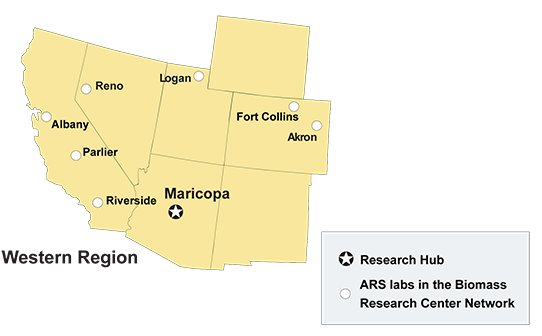Western Regional Biomass Research Center (WRBRC)

The Western Regional Biomass Research Center (WRBRC) is one of four regional USDA Biomass Research Centers. The WRBRC consists of a network of existing ARS facilities and scientists located in Arizona, California, Colorado, Nevada and Utah.
WRBRC Research Focus Areas
Feedstock Development
ARS scientists are using next-generation sequencing technologies to develop markers enabling direct linkages with genomes of switchgrass, guayule and Brassica napus to advance breeding studies to select desirable traits. Research is examining the genetics and biochemical pathways that regulate oil production and accumulation in plants. ARS scientists are exploring the potential use of wild ryegrass to improve rangeland forage production and also provide a new potential low-input perennial grass feedstock.
Feedstock Production
ARS scientists are examining the role of bioenergy crops such as switchgrass to improve soil properties and reduce greenhouse gas emissions through crop rotation schemes in rain-fed production areas. Other research is exploring crop rotation systems to economically optimize feedstock production. Simulation models are being used to predict biomass yields and greenhouse gas fluxes in various biofuel cropping systems in three states. Guayule, a natural rubber latex producing plant native to the southwestern U.S., is being developed as an alternative to petroleum as a source of latex and rubber and for biomass for energy production. ARS research on guayule is focused on multiple fronts including, chemical characterization and latex extraction technology, genomic and transcriptomic research to facilitate genetic modification for yield enhancement, and agronomics, including systems for direct seeding. Research is identifying plants that can be produced sustainably with salt and boron laden water sources.
Feedstock Conversion
ARS Scientists are working with a commercial landfill that utilizes a variety of biomass feedstocks to produce ethanol, compost material and/or biogas. ARS and industry research on guayule is focused on multiple fronts (noted above), including life cycle analysis comparing petroleum-based and bio-based tire manufacturing, and design, construction, and testing of commercial passenger tires. Additional research effort is focused on Kazak dandelion as another natural source of rubber, inulin and biomass for bioenergy production. Genetic improvement of lesquerella, an oilseed crop with high levels of hydroxy fatty acids, is underway. The oils have biomass application as well as other industrial uses. Castor is another potentially valuable source of hydroxyl fatty acids, but there is concern with the by-product ricin. Research has identified processes that eliminate ricin in seed cakes and identified castor cultivars with reduced ricin levels. Biochar is being examined as a soil amendment to improve fertility and mitigate climate change. Torrefied crop waste is being explored as a replacement for carbon black. The publically accessible portions of the GRACEnet and REAP database continue to expand and currently has 61 registered users. The system also has been made available to parties interested in bioenergy feedstock via DOE's Knowledge Discovery Framework.
